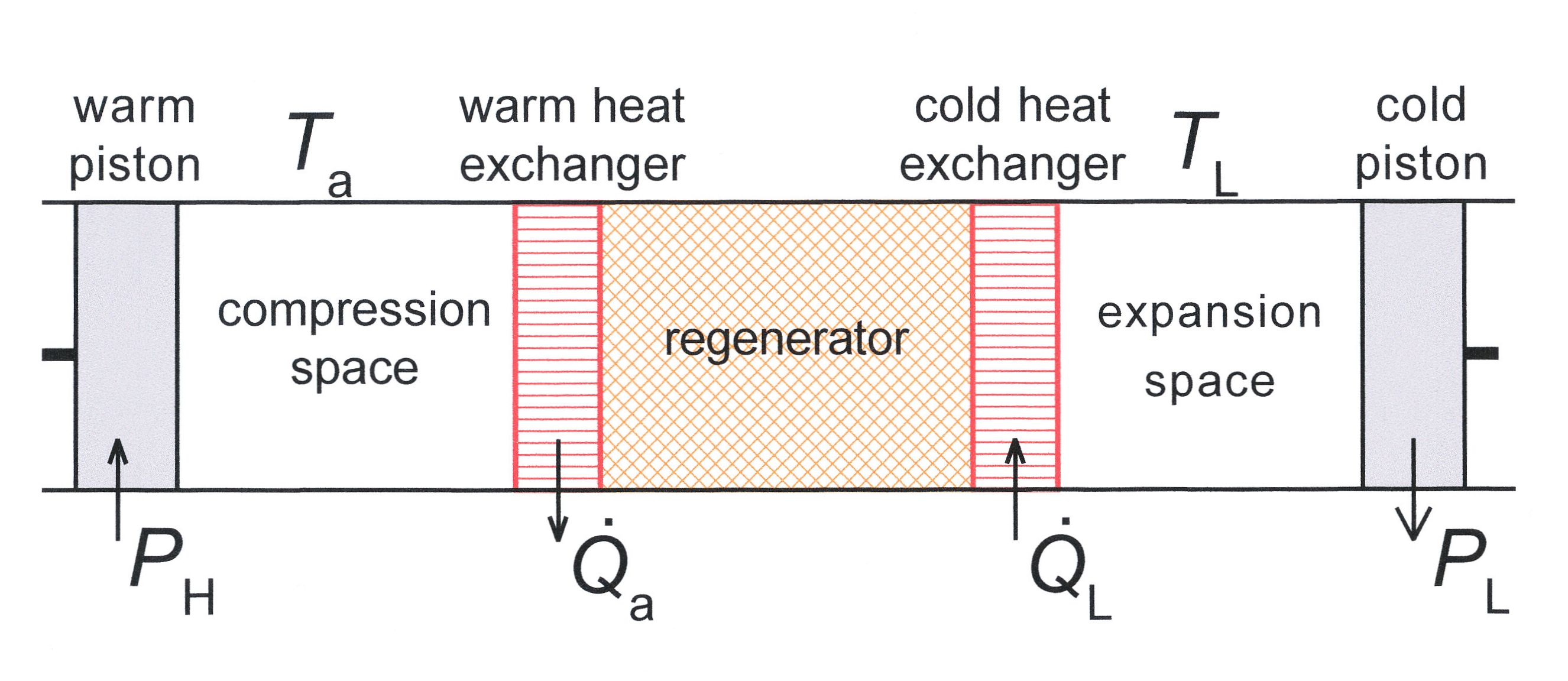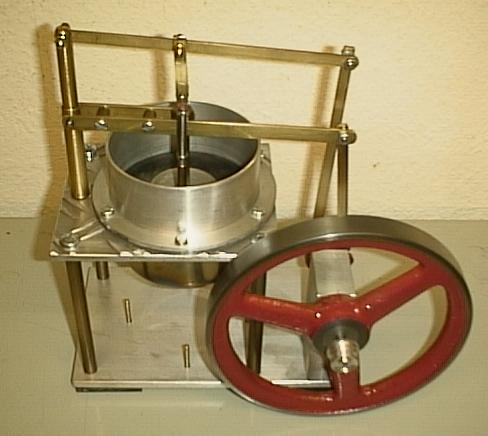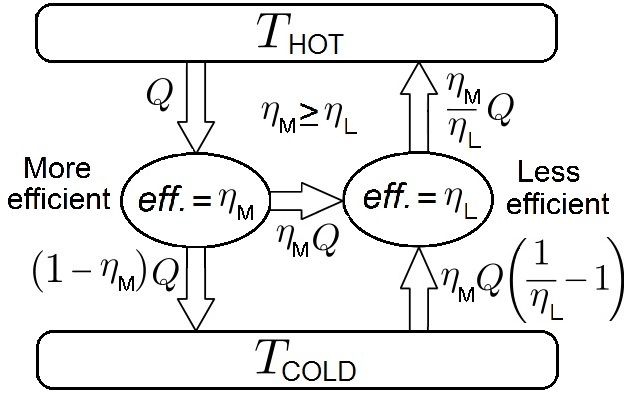|
Pulse Tube Refrigerator
The pulse tube refrigerator (PTR) or pulse tube cryocooler is a developing technology that emerged largely in the early 1980s with a series of other innovations in the broader field of thermoacoustics. In contrast with other cryocoolers (e.g. Stirling cryocooler and GM-refrigerators), this cryocooler can be made without moving parts in the low temperature part of the device, making the cooler suitable for a wide variety of applications. Uses Pulse tube cryocoolers are used in industrial applications such as semiconductor fabrication and in military applications such as for the cooling of infrared sensors. Pulse tubes are also being developed for cooling of astronomical detectors where liquid cryogens are typically used, such as the Atacama Cosmology Telescope or the Qubic experiment (an interferometer for cosmology studies). PTRs are used as precoolers of dilution refrigerators. Pulse tubes are particularly useful in space-based telescopes such as the James Webb Space Tele ... [...More Info...] [...Related Items...] OR: [Wikipedia] [Google] [Baidu] |
Thermoacoustics
Thermoacoustics is the interaction between temperature, density and pressure variations of acoustic waves. Thermoacoustic heat engines can readily be driven using solar energy or waste heat and they can be controlled using proportional control. They can use heat available at low temperatures which makes it ideal for heat recovery and low power applications. The components included in thermoacoustic engines are usually very simple compared to conventional engines. The device can easily be controlled and maintained. Thermoacoustic effects can be observed when partly molten glass tubes connected to glass vessels. Sometimes spontaneously a loud and monotone sound is produced. A similar effect is observed if one side of a stainless steel tube is at room temperature (293 K) and the other side is in contact with liquid helium at 4.2 K. In this case, spontaneous oscillations are observed which are named "Taconis oscillations". The mathematical foundation of thermoacoustics is ... [...More Info...] [...Related Items...] OR: [Wikipedia] [Google] [Baidu] |
Helium
Helium (from el, ἥλιος, helios, lit=sun) is a chemical element with the symbol He and atomic number 2. It is a colorless, odorless, tasteless, non-toxic, inert, monatomic gas and the first in the noble gas group in the periodic table. Its boiling and melting point are the lowest among all the elements. It is the second lightest and second most abundant element in the observable universe (hydrogen is the lightest and most abundant). It is present at about 24% of the total elemental mass, which is more than 12 times the mass of all the heavier elements combined. Its abundance is similar to this in both the Sun and in Jupiter, due to the very high nuclear binding energy (per nucleon) of helium-4, with respect to the next three elements after helium. This helium-4 binding energy also accounts for why it is a product of both nuclear fusion and radioactive decay. The most common isotope of helium in the universe is helium-4, the vast majority of which was formed during t ... [...More Info...] [...Related Items...] OR: [Wikipedia] [Google] [Baidu] |
Cooling Technology
Cooling is removal of heat, usually resulting in a lower temperature and/or phase change. Temperature lowering achieved by any other means may also be called cooling.ASHRAE Terminology, https://www.ashrae.org/technical-resources/free-resources/ashrae-terminology The transfer of thermal energy may occur via thermal radiation, heat conduction or convection. Examples can be as simple as reducing temperature of a coffee. Devices * Coolant * Cooling towers, as used in large industrial plants and power stations * Daytime passive radiative cooler * Evaporative cooler * Heat exchanger * Heat pipe *Heat sink * HVAC (Heating, Ventilation and Air Conditioning) * Intercooler *Radiative cooling in Heat shields * Radiators in automobiles * Pumpable ice technology * Thermoelectric cooling *Vortex tube The vortex tube, also known as the Ranque-Hilsch vortex tube, is a mechanical device that separates a compressed gas into hot and cold streams. The gas emerging from the hot end can re ... [...More Info...] [...Related Items...] OR: [Wikipedia] [Google] [Baidu] |
Timeline Of Low-temperature Technology
The following is a timeline of low-temperature technology and cryogenic technology (refrigeration down to –273.15 °C, –459.67 °F or 0 K). It also lists important milestones in thermometry, thermodynamics, statistical physics and calorimetry, that were crucial in development of low temperature systems. Prior to the 19th century * – Zimri-Lim, ruler of Mari in Syria commanded the construction of one of the first ice houses near the Euphrates. * – The yakhchal (meaning "ice pit" in Persian) is an ancient Persian type of refrigerator. The structure was formed from a mortar resistant to heat transmission, in the shape of a dome. Snow and ice was stored beneath the ground, effectively allowing access to ice even in hot months and allowing for prolonged food preservation. Often a badgir was coupled with the yakhchal in order to slow the heat loss. Modern refrigerators are still called yakhchal in Persian. * - Hero of Alexandria knew of the principle that cer ... [...More Info...] [...Related Items...] OR: [Wikipedia] [Google] [Baidu] |
Regenerative Cooling
Regenerative cooling is a method of cooling gases in which compressed gas is cooled by allowing it to expand and thereby take heat from the surroundings. The cooled expanded gas then passes through a heat exchanger where it cools the incoming compressed gas. Regenerative cycles *Stirling cycle * Gifford–McMahon cycle * Vuilleumier cycle *Pulse tube refrigerator History In 1857, Siemens introduced the regenerative cooling concept with the Siemens cycle. In 1895, William Hampson in England and Carl von Linde in Germany independently developed and patented the Hampson–Linde cycle to liquefy air using the Joule–Thomson expansion process and regenerative cooling. On 10 May 1898, James Dewar used regenerative cooling to become the first to statically liquefy hydrogen. See also *Cryocooler *Displacer *Fluid mechanics *Regenerative cooling (rocket) *Regenerative heat exchanger *Thermodynamic cycle A thermodynamic cycle consists of a linked sequence of thermodynamic processes ... [...More Info...] [...Related Items...] OR: [Wikipedia] [Google] [Baidu] |
Cryocooler
A refrigerator designed to reach cryogenic temperatures (below ) is often called a cryocooler. The term is most often used for smaller systems, typically table-top size, with input powers less than about 20 kW. Some can have input powers as low as 2–3 W. Large systems, such as those used for cooling the superconducting magnets in particle accelerators are more often called cryogenic refrigerators. Their input powers can be as high as 1 MW. In most cases cryocoolers use a cryogenic fluid as the working substance and employ moving parts to cycle the fluid around a thermodynamic cycle. The fluid is typically compressed at room temperature, precooled in a heat exchanger, then expanded at some low temperature. The returning low-pressure fluid passes through the heat exchanger to precool the high-pressure fluid before entering the compressor intake. The cycle is then repeated. __TOC__ Ideal heat exchangers and regenerators Heat exchangers are important components of all cry ... [...More Info...] [...Related Items...] OR: [Wikipedia] [Google] [Baidu] |
Stirling Engine
A Stirling engine is a heat engine that is operated by the cyclic compression and expansion of air or other gas (the ''working fluid'') between different temperatures, resulting in a net conversion of heat energy to mechanical work. More specifically, the Stirling engine is a closed-cycle regenerative heat engine with a permanent gaseous working fluid. ''Closed-cycle'', in this context, means a thermodynamic system in which the working fluid is permanently contained within the system, and ''regenerative'' describes the use of a specific type of internal heat exchanger and thermal store, known as the ''regenerator''. Strictly speaking, the inclusion of the regenerator is what differentiates a Stirling engine from other closed-cycle hot air engines. In the Stirling engine, a gas is heated and expanded by energy supplied from outside the engine's interior space (cylinder). It is then shunted to a different location within the engine, where it is cooled and compressed. A piston (o ... [...More Info...] [...Related Items...] OR: [Wikipedia] [Google] [Baidu] |
Carnot's Theorem (thermodynamics)
In thermodynamics, Carnot's theorem, developed in 1824 by Nicolas Léonard Sadi Carnot, also called Carnot's rule, is a principle that specifies limits on the maximum efficiency that any heat engine can obtain. Carnot's theorem states that all heat engines operating between the same two thermal or heat reservoirs can't have efficiencies greater than a reversible heat engine operating between the same reservoirs. A corollary of this theorem is that every reversible heat engine operating between a pair of heat reservoirs is equally efficient, regardless of the working substance employed or the operation details. Since a Carnot heat engine is also a reversible engine, the efficiency of all the reversible heat engines is determined as the efficiency of the Carnot heat engine that depends solely on the temperatures of its hot and cold reservoirs. The maximum efficiency (i.e., the Carnot heat engine efficiency) of a heat engine operating between cold and hot reservoirs, denoted as ... [...More Info...] [...Related Items...] OR: [Wikipedia] [Google] [Baidu] |
Coefficient Of Performance
The coefficient of performance or COP (sometimes CP or CoP) of a heat pump, refrigerator or air conditioning system is a ratio of useful heating or cooling provided to work (energy) required. Higher COPs equate to higher efficiency, lower energy (power) consumption and thus lower operating costs. The COP usually exceeds 1, especially in heat pumps, because, instead of just converting work to heat (which, if 100% efficient, would be a COP of 1), it pumps additional heat from a heat source to where the heat is required. Most air conditioners have a COP of 2.3 to 3.5. Less work is required to move heat than for conversion into heat, and because of this, heat pumps, air conditioners and refrigeration systems can have a coefficient of performance greater than one. However, this does not mean that they are more than 100% efficient, in other words, no heat engine can have a thermal efficiency of 100% or greater. For complete systems, COP calculations should include energy consumption o ... [...More Info...] [...Related Items...] OR: [Wikipedia] [Google] [Baidu] |
Coaxial Pulse Tube
In geometry, coaxial means that several three-dimensional linear or planar forms share a common axis. The two-dimensional analog is '' concentric''. Common examples: A coaxial cable is a three-dimensional linear structure. It has a wire conductor in the centre (D), a circumferential outer conductor (B), and an insulating medium called the dielectric (C) separating these two conductors. The outer conductor is usually sheathed in a protective PVC outer jacket (A). All these have a common axis. The dimension and material of the conductors and insulation determine the cable's characteristic impedance and attenuation at various frequencies. Coaxial rotors are a three-dimensional planar structure: a pair of helicopter rotors (wings) mounted one above the other on concentric shafts, with the same axis of rotation (but turning in opposite directions). In loudspeaker design, coaxial speakers A coaxial loudspeaker is a loudspeaker system in which the individual driver units radiate ... [...More Info...] [...Related Items...] OR: [Wikipedia] [Google] [Baidu] |





